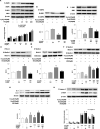Resveratrol protects osteocytes against oxidative stress in ovariectomized rats through AMPK/JNK1-dependent pathway leading to promotion of autophagy and inhibition of apoptosis
- PMID: 36681672
- PMCID: PMC9867734
- DOI: 10.1038/s41420-023-01331-2
Resveratrol protects osteocytes against oxidative stress in ovariectomized rats through AMPK/JNK1-dependent pathway leading to promotion of autophagy and inhibition of apoptosis
Abstract
A large number of studies in recent years indicate that osteocytes are the orchestrators of bone remodeling by regulating both osteoblast and osteoclast activities. Oxidative stress-induced osteocyte apoptosis plays critical roles in the pathological processes of postmenopausal osteoporosis. Resveratrol is a natural polyphenolic compound that ameliorates postmenopausal osteoporosis. However, whether resveratrol regulates osteocyte apoptosis via autophagy remains largely unknown. The effects of resveratrol on regulating osteocyte apoptosis and autophagy were analyzed both in vivo and in vitro. In vitro, cultured MLO-Y4 cells were exposed to H2O2 with or without resveratrol. In vivo, an ovariectomy-induced osteoporosis model was constructed in rats with or without daily intraperitoneal injection of 10 mg/kg body weight resveratrol. It was found that resveratrol attenuated H2O2-induced apoptosis through activating autophagy in cultured MLO-Y4 cells, which was mediated by the dissociation of Beclin-1/Bcl-2 complex in AMPK/JNK1-dependent pathway, ultimately regulating osteocytes function. Furthermore, it was shown that resveratrol treatment reduced osteocytes oxidative stress, inhibited osteocytes apoptosis and promoted autophagy in ovariectomized rats. Our study suggests that resveratrol protects against oxidative stress by restoring osteocytes autophagy and alleviating apoptosis via AMPK/JNK1 activation, therefore dissociating Bcl-2 from Beclin-1.
© 2023. The Author(s).
Conflict of interest statement
The authors declare no competing interests.
Figures








Similar articles
-
Pinocembrin alleviates glucocorticoid-induced apoptosis by activating autophagy via suppressing the PI3K/Akt/mTOR pathway in osteocytes.Eur J Pharmacol. 2020 Aug 5;880:173212. doi: 10.1016/j.ejphar.2020.173212. Epub 2020 May 26. Eur J Pharmacol. 2020. PMID: 32470335
-
miR-199a-3p is involved in estrogen-mediated autophagy through the IGF-1/mTOR pathway in osteocyte-like MLO-Y4 cells.J Cell Physiol. 2018 Mar;233(3):2292-2303. doi: 10.1002/jcp.26101. Epub 2017 Aug 25. J Cell Physiol. 2018. PMID: 28708244
-
Alpinumisoflavone rescues glucocorticoid-induced apoptosis of osteocytes via suppressing Nox2-dependent ROS generation.Pharmacol Rep. 2018 Apr;70(2):270-276. doi: 10.1016/j.pharep.2017.11.001. Epub 2017 Nov 4. Pharmacol Rep. 2018. Retraction in: Pharmacol Rep. 2021 Feb;73(1):322. doi: 10.1007/s43440-020-00211-1. PMID: 29477034 Retracted.
-
PTH 1-34 reduced apoptosis of MLO-Y4 osteocyte-like cells by activating autophagy and inhibiting ER stress under RPM conditions.Eur J Pharmacol. 2024 Mar 15;967:176364. doi: 10.1016/j.ejphar.2024.176364. Epub 2024 Feb 3. Eur J Pharmacol. 2024. PMID: 38316249
-
Autophagy in Bone Remodeling: A Regulator of Oxidative Stress.Front Endocrinol (Lausanne). 2022 Jun 30;13:898634. doi: 10.3389/fendo.2022.898634. eCollection 2022. Front Endocrinol (Lausanne). 2022. PMID: 35846332 Free PMC article. Review.
Cited by
-
Autophagy: regulating the seesaw of bone-fat balance.Front Cell Dev Biol. 2025 Feb 24;13:1465092. doi: 10.3389/fcell.2025.1465092. eCollection 2025. Front Cell Dev Biol. 2025. PMID: 40066259 Free PMC article. Review.
-
A Systematic Review on the Molecular Mechanisms of Resveratrol in Protecting Against Osteoporosis.Int J Mol Sci. 2025 Mar 22;26(7):2893. doi: 10.3390/ijms26072893. Int J Mol Sci. 2025. PMID: 40243497 Free PMC article.
-
Plant molecules reinforce bone repair: Novel insights into phenol-modified bone tissue engineering scaffolds for the treatment of bone defects.Mater Today Bio. 2023 Dec 21;24:100920. doi: 10.1016/j.mtbio.2023.100920. eCollection 2024 Feb. Mater Today Bio. 2023. PMID: 38226013 Free PMC article. Review.
-
Prevention and Co-Management of Breast Cancer-Related Osteoporosis Using Resveratrol.Nutrients. 2024 Feb 29;16(5):708. doi: 10.3390/nu16050708. Nutrients. 2024. PMID: 38474838 Free PMC article. Review.
-
Exploring the application of dietary antioxidant index for disease risk assessment: a comprehensive review.Front Nutr. 2025 Jan 16;11:1497364. doi: 10.3389/fnut.2024.1497364. eCollection 2024. Front Nutr. 2025. PMID: 39885868 Free PMC article. Review.
References
-
- Farr JN, Rowsey JL, Eckhardt BA, Thicke BS, Fraser DG, Tchkonia T, et al. Independent roles of estrogen deficiency and cellular senescence in the pathogenesis of osteoporosis: evidence in young adult mice and older humans. J Bone Miner Res. 2019;34:1407–18. doi: 10.1002/jbmr.3729. - DOI - PMC - PubMed
-
- Watson SL, Weeks BK, Weis LJ, Harding AT, Horan SA, Beck BR. High-intensity resistance and impact training improves bone mineral density and physical function in postmenopausal women with osteopenia and osteoporosis: The LIFTMOR randomized controlled trial. J Bone Miner Res. 2018;33:211–20. doi: 10.1002/jbmr.3284. - DOI - PubMed
Grants and funding
LinkOut - more resources
Full Text Sources
Research Materials
Miscellaneous

